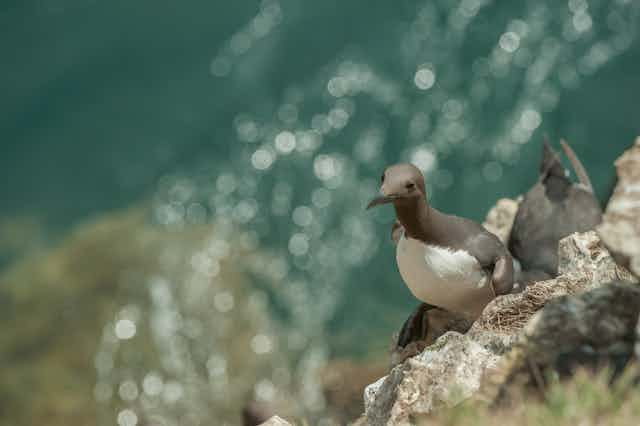The sight of an oiled seabird is mercifully rare these days. I cannot imagine a more appalling way to die.
The guillemot, a small penguin-like (but flighted) seabird, is especially vulnerable to oil and, over the past century, hundreds of thousands – possibly millions – have perished as a result of ships flushing out their bilges, tankers breaking up, or ships sinking.
In a new study, I have shown that oil pollution caused a 95% reduction in the guillemot population of Skomer Island in Wales – and probably much of the rest of southern and western Britain.
Skomer, a tiny speck of land just off the rugged Pembrokeshire coast, is surrounded by high cliffs which keep foxes and rats away and have turned the island into a world-renowned seabird paradise.

I have studied the island’s guillemots each year since 1972, and over that time have built up a good understanding of how their population works (how long they live, the age at which they first start to breed, their reproductive output and so on). Colleagues and I collect this data partly for academic research but also because annual documentation of such population measures is an essential part of monitoring – that is, keeping an careful eye on how the population is doing. High quality monitoring is our only ammunition against those forces that are driving much of our wildlife towards extinction.
My study began as a PhD. Guillemot (and other seabird) numbers were in decline, in part because of the 1967 Torrey Canyon oil tanker disaster, followed two years later by a mysterious mass die-off of guillemots thought to have been due to toxic chemicals. When I started in 1972 there were just 3,500 individual guillemots on Skomer. The aim of my PhD was to try to understand their population dynamics. A three-year PhD was too short however, for a bird that can live up to 40 years, so I continued – and have done so ever since.
By the mid 1980s, to my surprise and delight, the population started to increase – and it has continued to do so at a rate of about 5% per annum ever since, and numbers on Skomer now stand at 25,000 birds.

One would imagine that this increase would have been viewed very positively, but in 2014 the Welsh government used it as an excuse to terminate the modest (but adequate) funding that it had indirectly provided for the previous 25 years. The argument was that if the population was increasing there was nothing to worry about – that is, they saw no value in long-term high quality monitoring. So far I have managed to keep the study going by crowd funding, but that will run out in two years.
Can guillemots ever recover to their 1930s level?
In any case, even at 25,000 birds, the Skomer guillemot population is still just a fraction of what it had been a few decades earlier.
I knew of a set of photographs taken on Skomer in 1934 that allowed me – using 40 years of guillemot expertise – to estimate the guillemot population as it was then: at that time there were at least 100,000 birds on Skomer.

The person who so presciently took those pictures was local seabird expert Ronald Lockley. He also provided some written records, stating that when he returned to Skomer after the end of World War II he noticed a massive drop in guillemot numbers. He couldn’t be any more precise, because prior to my PhD, no one knew how to count these birds. Lockley also commented on the abundance of oil and oiled guillemots on the shores of Skomer and the adjacent mainland.
In an attempt to test the idea that oil pollution was responsible for the decline in Skomer’s guillemots I plotted the numbers of ships sunk – that would result in the release of oil – in the years before, during and after the war. I did this with some care, restricting my search to those areas that we know (from geolocator tracking) where Skomer guillemots spend the winter.
The pattern was clear: very few ships sunk prior to 1939, follow by a two-hundred fold increase in the first two years of World War II, and very few thereafter. As with all attempts to reconstruct the past, the evidence is circumstantial, but it all fits: a 95% reduction in Skomer’s guillemot between the start and end of the war; a huge number of sunk ships releasing oil during the conflict – and abundant observations of oil-covered birds.
Until this study, there had been speculation that the current increase might be a consequence of climate change or a change in fishing activity, but it is equally possible that it could simply be a recovery from that wartime crash. With our knowledge of the guillemot’s population biology we know that if nothing else intervenes, it will take another 30 years to get back to those 1930s levels.

